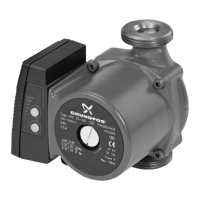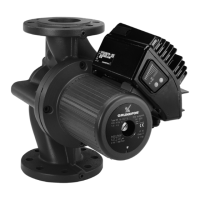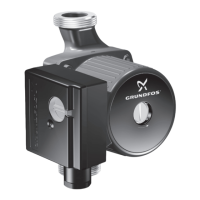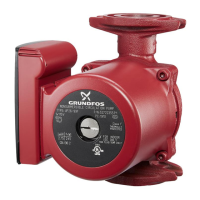23
8. Fault finding chart
See also section 6.6 Indicator lights.
Note: The R100 can also be used for fault finding.
Before removing the terminal box cover, make sure that the electricity supply has been switched off
for at least 5 minutes. The voltage to a possible fault signal module must also have been switched
off.
The pumped liquid may be scalding hot and under high pressure. Before any removal or dismantling
of the pump, the system must therefore be drained or the isolating valves on either side of the pump
must be closed.
Fault Cause Remedy
The pump is not run-
ning.
A fuse in the installation is blown. Replace the fuse.
Current/voltage-operated earth-leakage cir-
cuit breaker has tripped out.
Cut in the circuit breaker.
Electricity supply failure (e.g. overvoltage or
undervoltage).
Check that the electricity supply falls
within the specified range.
The pump is defective. Replace the pump.
The pump is not run-
ning.
The green indicator
light is flashing.
The pump has been stopped in one of the
following ways:
1. With the button “–”.
2. With the R100.
3. External on/off switch in position off
(expansion module).*
4. Via bus signal (bus module).*
1. Start the pump by pressing “+”.
2. Start the pump with the R100 or
by pressing “+”.
3. Switch on the on/off switch.*
4. Start the pump via bus signal.*
* The fault can be temporarily corrected by selecting max. curve duty on the pump or
with the R100, as external forced-control signals will be ignored.
The pump has
stopped due to a fault.
The red indicator light
is on and the green in-
dicator light is off.
The pump has stopped because of too high
ambient or liquid temperature.
Check that the ambient and liquid
temperatures fall within the specified
ranges.
Pump blocked and/or impurities in the pump. Remove the air vent screw and turn
the rotor by means of a screwdriver
inserted into the slot in the shaft end,
and/or dismantle and clean the pump.
Noise in the system.
The green indicator
light is on.
Air in the system. Vent the system.
The flow is too high. Reduce the head (setpoint) and pos-
sibly change over to constant pres-
sure.
The pressure is too high. Reduce the head (setpoint) and pos-
sibly change over to proportional
pressure.
Noise in the pump.
The green indicator
light is on.
Air in the pump. Vent the pump.
The inlet pressure is too low. Increase the inlet pressure and/or
check air volume in the expansion
tank (if installed).
Insufficient heat in
some places in the
heating system.
The pump flow is too low. Increase the head (setpoint) and/or
change over to constant pressure.

